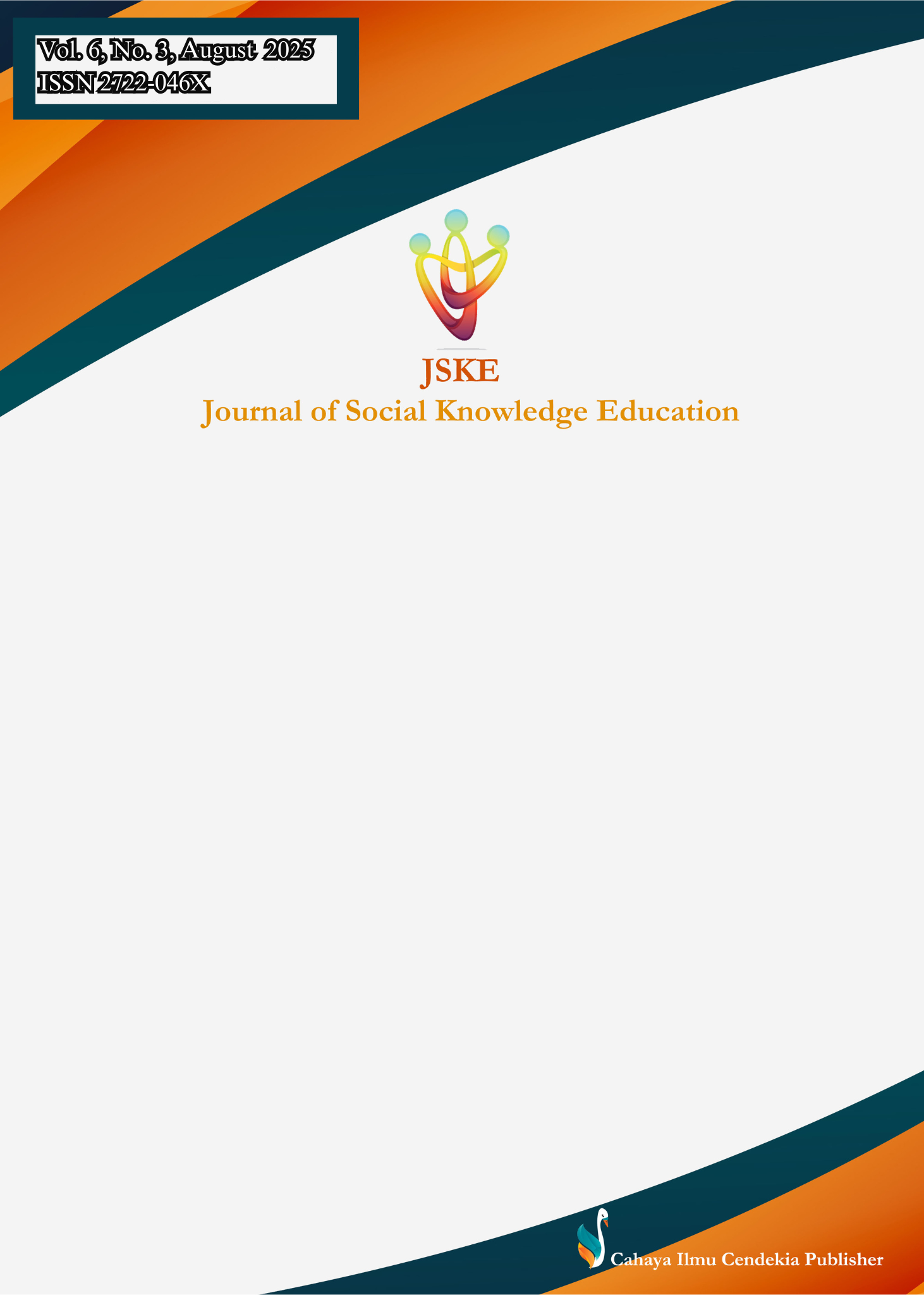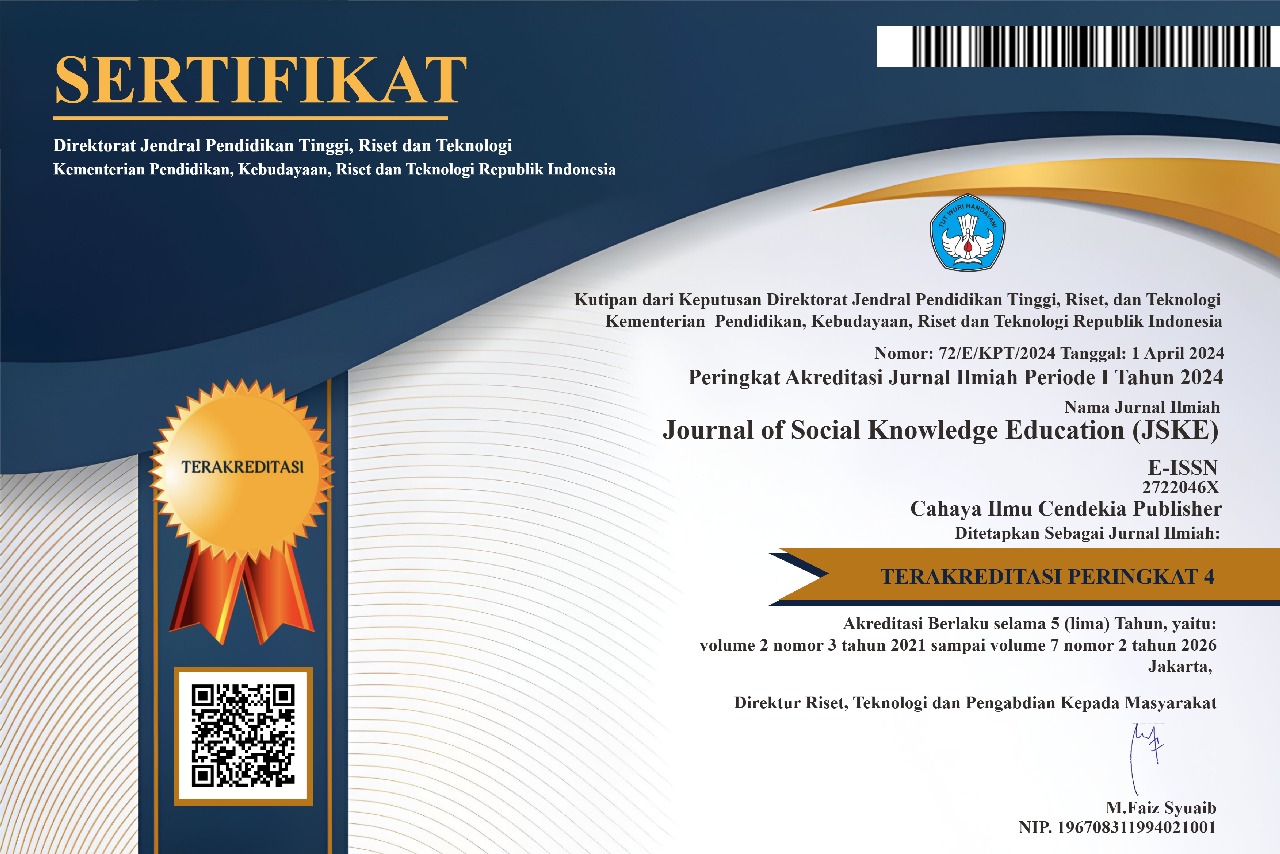Examining the Service Quality of Prison Education for Women in Cambodia: A Case Study of the 2nd Correctional Center
Abstract
Purpose: This study evaluates the service quality of prison education for women at Cambodia’s 2nd Correctional Center by comparing prisoners’ expectations with their actual experiences. It identifies institutional and psychosocial barriers affecting service delivery, learning outcomes, and program effectiveness.
Methodology: A mixed-methods approach was used. Quantitative data were collected through structured surveys of 170 women prisoners and analyzed using a paired t-test. Qualitative insights were drawn from semi-structured interviews with 20 prisoners and 5 prison officers, analyzed thematically. Triangulation ensured validity and credibility.
Findings: Statistical results showed no significant difference between expectations and perceptions (t = 0.40, p = 0.69), with a negligible mean gap (0.02). However, qualitative data revealed that the apparent alignment stemmed from structurally low expectations, limited educational relevance, trauma, and underinvestment. Women perceived minimal services as “good enough,” reflecting constrained standards rather than actual satisfaction.
Novelty: This is among the first studies in Cambodia to apply the Servqual model to women’s prison education using both quantitative and gender-sensitive qualitative data. It highlights the systemic neglect of incarcerated women’s educational rights and argues for trauma-informed, gender-responsive reforms to ensure prison education is truly rehabilitative.
References
N. G. Vandala, “The transformative effect of correctional education: A global perspective,” Cogent Soc Sci, vol. 5, no. 1, Jan. 2019, doi: 10.1080/23311886.2019.1677122.
R. Galeshi and R. M. Bolin, “The influence of correctional education, skill proficiency, and lifelong learning on social outcomes of incarcerated individuals: Results from PIAAC,” Social Science Journal, vol. 59, no. 3, pp. 424–438, 2022, doi: 10.1016/j.soscij.2019.09.007.
S. L. Allred, C. Boyd, T. Cotton, and P. Perry, “Participatory Evaluation in a Prison Education Program: Meaning & Community Building within Inside-Out Think Tanks,” Corrections, vol. 5, no. 1, pp. 6–27, 2020, doi: 10.1080/23774657.2019.1604193.
G. O. Vila et al., “Analysis of a sports-educational program in prisons,” Int J Environ Res Public Health, vol. 17, no. 10, May 2020, doi: 10.3390/ijerph17103467.
H. Kaatrakoski, “Learning in and for work in correctional services in Norway,” Stavanger, Nov. 2022. doi: 10.31265/USPS.251.
F. Dünkel, “The Impact of Covid-19 on Prisons and Penal Policy in Germany,” Vict Offender, vol. 15, no. 7–8, pp. 1113–1123, 2020, doi: 10.1080/15564886.2020.1813230.
V. P. Mahlangu, “Examining The Time Prisoners Study Using E-Learning While In Prison: Sustainability of E-Learning Programs in Prison,” Discourse and Communication for Sustainable Education, vol. 15, no. 2, pp. 45–61, Dec. 2024, doi: 10.2478/dcse-2024-0015.
Thailand Institute of Justice (TIJ), “Women prisoner and the implementation of the Bangkok rules in Thailand,” 2014. [Online]. Available: www.tijthailand.org
Thailand Institute of Justice (TIJ), “Bangkok Dialogue on the rule of law,” 2014.
B. Dhiman, “Condition of Women Prisoners in Model Jail, Chandigarh: A Communication Study,” SSRN, Aug. 2022, doi: https://dx.doi.org/10.2139/ssrn.4205096.
L. B. Ondras and J. R. Alvero, “Senior High Program in Prison Culture: Its Rehabilitative effect during and after Incarceration,” American Journal of Humanities and Social Sciences Research, vol. 5, pp. 21–30, 2022, [Online]. Available: www.theajhssr.com
S. Chokprajakchat and W. Techagaisiyavanit, “Women Prisons in North-Eastern Thailand: How Well Do They Meet International Human Rights Standards?,” International Journal for Crime, Justice and Social Democracy, vol. 8, no. 4, pp. 123–136, Nov. 2019, doi: 10.5204/ijcjsd.v8i4.1186.
S. Jeffries, Y. Thipphayamongkoludom, and C. Chuenurah, “Working ‘from the heart’ under challenging circumstances: Thailand’s probation workers discuss electronically monitored parole for women,” Probation Journal, 2025, doi: 10.1177/02645505241303751.
S. Jeffries and A. M. Jefferson, “Introduction to Gender, Criminalization, Imprisonment and Human Rights in Southeast Asia,” in Gender, Criminalization, Imprisonment and Human Rights in Southeast Asia, Emerald Publishing Limited, 2022, pp. 1–11. doi: 10.1108/978-1-80117-286-820221001.
Royal Government of Cambodia, Prison law. Phnom Penh: Royal Government of Cambodia, 2011.
Ministry of Interior, “Annual report,” Phnom Penh, 2024.
Licado, “Rights At A Price: Life Inside Cambodia’s Prisons,” 2015. [Online]. Available: www.twitter.com/licadho
R. Broadhurst, T. Bouhours, and B. Bouhours, “Violence and the Civilising Process in Cambodia,” Cambridge University Press, 2015. [Online]. Available: http://ssrn.com/abstract=2695955
This Life Cambodia, “Why children accompany mothers into prison An insight into factors influencing this decision in Cambodia,” 2019. [Online]. Available: www.thislifecambodia.org
P. Pat, “Insights from Inside: Addressing mental health, well-being and healthcare needs of young prisoners in Cambodia,” Journal of Community Systems for Health, vol. 1, no. 1, Oct. 2024, doi: 10.36368/jcsh.v1i1.1088.
G. N. Kenyon and K. C. Sen, The Perception of Quality Mapping Product and Service Quality to Consumer Perceptions. London, 2015. doi: 10.1007/978-1-4471-6627-6.
Y. Susanto, R. A. Rodia, and F. Indriani, “Service Quality of Lubuklinggau Prison,” vol. 4, no. 1, 2024, doi: 10.36908/jimpa.
A. Brysland and A. Curry, “Service improvements in public services using SERVQUAL,” Managing Service Quality: An International Journal, vol. 11, no. 6, pp. 389–401, Dec. 2001, doi: 10.1108/09604520110410601.
L. M. Davis, R. Bozick, J. L. Steele, J. Saunders, and J. N. V Miles, “Evaluating the Effectiveness of Correctional Education: A Meta-Analysis of Programs That Provide Education to Incarcerated Adults,” 2013. [Online]. Available: www.rand.org
A. Petre and M. Tomiţă, “Education in Prisons-An Essential Factor in Preventing Recidivism-The Role of Detention Officers in the Educational Process,” Journal of Community Positive Practices, vol. 22, no. 2, pp. 99–106, 2022, doi: 10.35782/JCPP.2022.2.07.
A. Parasuraman, L. L. Berry, and V. A. Zeithaml, “Perceived Service Quality as a Customer-Based Performance Measure: An Empirical Examination of Organizational Barriers Using an Extended Service Quality Model,” vol. 30, no. 3, pp. 335–364, 2006, doi: 10.1002/hrm.3930300304.
S. Costa and S. R. G. Fernandes, “Developing Social Skills in the Prison Context – Results from the Implementation of a Training Program with Prisoners,” Research on Humanities and Social Sciences, Jun. 2021, doi: 10.7176/rhss/11-11-06.
A. Rolo, R. Alves, M. Saraiva, and G. Leandro, “The SERVQUAL instrument to measure service quality in higher education – A case study,” SHS Web of Conferences, vol. 160, p. 01011, 2023, doi: 10.1051/shsconf/202316001011.
T. Tarnanidis and J. Tarnanidis, “Analyzing the SERVQUAL Method for Senior High School Education’s Gaps and Factors,” European Journal of Educational Management, vol. 7, no. 4, pp. 227-243., Dec. 2024, doi: 10.12973/eujem.7.4.227.
O. Goumairi, E. S. Aoula, and S. B. E. N. Souda, “Application of the servqual model for the evaluation of the service quality in Moroccan higher education: Public engineering school as a case study,” International Journal of Higher Education, vol. 9, no. 5, pp. 223–229, 2020, doi: 10.5430/ijhe.v9n5p223.
J. M. Elbers, E. F. J. C. van Ginneken, P. Nieuwbeerta, M. Boone, and H. Palmen, “The effects of reward systems in prison: A systematic review,” Int J Law Crime Justice, vol. 71, Dec. 2022, doi: 10.1016/j.ijlcj.2022.100556.
S. Pazoki, M. Hajiahmadi, and E. Saffarieh, “The measurement of the quality of educational services provided to medical students of Semnan University of Medical Sciences based on the SERQUAL model,” J Family Med Prim Care, vol. 13, no. 4, pp. 1213–1218, Apr. 2024, doi: 10.4103/jfmpc.jfmpc_1007_23.
H. Gawande, “Prison Education: A Ray Hope for Jail Inmates to be a Better Individual in Life,” Int J Res Appl Sci Eng Technol, vol. 10, no. 12, pp. 1030–1031, Dec. 2022, doi: 10.22214/ijraset.2022.48029.
M. F. Aebi, E. Cocco, and L. Molnar, “Prisons and Prisoners in Europe 2022,” 2023. [Online]. Available: https://eds2020.populationeurope.org/en/
V. P. Mahlangu, “Exploring the Perceptions of Student Prisoners on Challenges with Supervisors in Prison Education,” Jurnal Penelitian dan Pengkajian Ilmu Pendidikan: e-Saintika, vol. 8, no. 3, pp. 410–434, Nov. 2024, doi: 10.36312/e-saintika.v8i3.1886.
S. Chaima Kajawo and L. Rose Johnson, “The Right to Education: Is it a Reality or a Pipe Dream for Incarcerated Young Prisoners in Malawi?,” Journal of Prison Education and Reentry, vol. 7, no. 3, p. 2023, 2023, doi: 10.25771/dzyv-7c36.
UNECSO, “Education in prison - A literature review,” Hamburg, 2021. Accessed: Mar. 12, 2025. [Online]. Available: https://unesdoc.unesco.org/ark:/48223/pf0000378059
J. Berglund, C. Bjursell, and M. Hugo, “Research on education in prisons: a scoping review,” International Journal of Lifelong Education, pp. 1–14, Feb. 2025, doi: 10.1080/02601370.2025.2465740.
D. B. Pestka, “Meaning and meaninglessness of education for convicts. Selected aspects of education for convicts in Poland and in Europe,” Social Sciences and Humanities Open, vol. 2, no. 1, Jan. 2020, doi: 10.1016/j.ssaho.2020.100053.
E. Gashi, “Prison Education Characteristics and Classroom Management by Prison Teachers,” SEEU Review, vol. 16, no. 2, pp. 104–113, Dec. 2021, doi: 10.2478/seeur-2021-0023.
P. Chr Breivik, “The Norwegian education system in prisons Paal Chr Breivik, County Governor of Vestland, Norway,” 2022. Accessed: Mar. 12, 2025. [Online]. Available: https://www.ucu.org.uk/
A. D. de Barros Filho, C. Leite, and A. M. R. Monteiro, “Education policies in prisons: an analysis focused on the 10 largest prison populations,” Revista Brasileira de Educação, vol. 28, 2023, doi: 10.1590/s1413-24782023280070.
T. Czerwinski, E. König, and T. Zaichenko, “Youth and adult education in prisons experiences from Central Asia, South America, North Africa and Europe,” 2020. Accessed: Jul. 24, 2024. [Online]. Available: https://www.dvv-international.de/fileadmin/files/ipe_69_eng_web.pdf
Sipar, “Education in Prison program,” 2022. Accessed: Mar. 12, 2025. [Online]. Available: https://sipar.org/
J. A. Ryder, “Enhancing female prisoners’ access to education,” International Journal for Crime, Justice and Social Democracy, vol. 9, no. 1, pp. 139–149, 2020, doi: 10.5204/ijcjsd.v9i1.1468.
S. C. r. Kajawo and L. R. Johnson, “Education of Incarcerated Young People in Malawi: Strategic Plan versus Reality,” Educational Policy Analysis and Strategic Research, vol. 18, no. 2, pp. 7–26, Jun. 2023, doi: 10.29329/epasr.2023.548.1.
J. Burchett, A. Weyembergh, and M. Ramat, “Prisons and detention conditions in the EU,” Feb. 2023. Accessed: Mar. 12, 2025. [Online]. Available: https://www.europarl.europa.eu/supporting-analyses
M. D. Romines, “Inmate Motivation to Participate in Education During Incarceration Based on Time Being Served,” La Jolla, 2021. Accessed: Mar. 12, 2025. [Online]. Available: https://www.proquest.com/docview/2644400403
S. Woodland, “Prison cultures: performance, resistance, desire,” Research in Drama Education: The Journal of Applied Theatre and Performance, vol. 25, no. 4, pp. 657–658, Oct. 2020, doi: 10.1080/13569783.2020.1825068.
L. McKendy and R. Ricciardelli, “The Pains of Imprisonment and Contemporary Prisoner Culture in Canada,” Prison Journal, vol. 101, no. 5, pp. 528–552, Nov. 2021, doi: 10.1177/00328855211048166.
P. Pat, K. Edin, B. Jegannathan, M. San Sebastian, and L. Richter Sundberg, “‘Overcrowded but lonely’: exploring mental health and well-being among young prisoners in Cambodia,” Int J Prison Health, vol. 19, no. 4, pp. 628–640, Nov. 2023, doi: 10.1108/IJPH-02-2023-0011.
D. Brosens, S. Marynissen, F. Lemmers, and F. Croux, “Distance education for dutch citizens detained abroad: A mixed-methods case study of the foundation ‘education behind foreign bars,’” Educ Sci (Basel), vol. 11, no. 2, pp. 1–20, Jan. 2021, doi: 10.3390/educsci11020041.
B. Gillham, Research Interviewing - The Range of Techniques. 2005.
S. Humble, Quantitative Analysis of Questionnaires. 2020.
N. M. Pace, J. M. Anderson, S. Anwar, D. Schlang, M. A. Bradley, and A. Chari, “Statistical Analysis of Presidential Pardons,” Mar. 2021. [Online]. Available: https://ssrn.com/abstract=3919202
Copyright (c) 2025 Reth Vicheka, Seng Dararaksmey

This work is licensed under a Creative Commons Attribution 4.0 International License.
Authors who publish with this journal agree to the following terms:
- Authors retain copyright and acknowledge that the Journal of social knowledge education (JSKE) is the first publisher licensed under a Creative Commons Attribution 4.0 International License.
- Authors are able to enter into separate, additional contractual arrangements for the non-exclusive distribution of the journal's published version of the work (e.g., post it to an institutional repository or publish it in a book), with an acknowledgment of its initial publication in this journal.
- Authors are permitted and encouraged to post their work online (e.g., in institutional repositories or on their website) prior to and during the submission process, as it can lead to productive exchanges and earlier and greater citation of published work.







.png)
.png)















